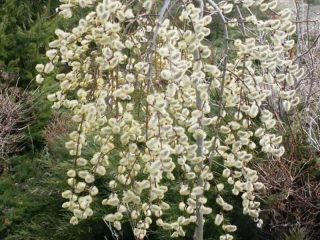Content
Willow Mayak (Salix Majak) is a low deciduous shrub with a spherical shape. This variety has gained popularity among landscape designers due to its ease of care and unique decorative qualities.
Origin
The Willow Mayak variety was bred in the Urals. The originator is the breeder Veniamin Ivanovich Shaburov. The Mayak hybrid was obtained on the basis of the purple willow (Salix purpurea). The flexible rods of the tree were originally intended exclusively for weaving household items (chairs, baskets, tables). But now shrubs are used mainly to create hedges, arches and tree and shrub groups in areas.
Description of Willow Mayak
Twig willow Mayak is a dense, low-growing, rounded bush with a powerful branched root system. This variety has a dense crown with long, thin and flexible reddish shoots directed upward. The olive-hued bark is thin and shiny.

The height of the willow reaches no more than 3 m with a crown diameter of up to 2.5-3 m
The plant is distinguished by elongated, lanceolate-shaped leaf blades. They are slightly pressed against the branches. The leaves are silver on the underside and green on the top. They reach no more than 15 cm in length.

In autumn the foliage changes color and becomes yellowish
Willow blooms in March or April. The bush blooms with a large number of pinkish-yellow flowers that do not have a scent. They are located on numerous purple earrings.
Fruits in the form of boxes crack almost to the base. Small seeds, covered with white fluff, germinate quickly when they fall into the soil.
The hybrid willow retains its decorative properties in winter. The variety is characterized by high winter hardiness - up to -40 °C, so it is suitable for growing in regions with harsh winters.
Difference between willow Mayak 1 and Mayak 2
Visually, both hybrids look almost identical, so the description of the willow Mayak 2 (Salix Majak-2) does not differ from the description of the appearance of the Mayak 1 variety (Salix Majak-1). But the Mayak 2 hybrid is considered more shade-tolerant and disease-resistant.

Willow Mayak 2 is called “Fireworks”, because when cutting the plant onto a stump, it is possible to achieve a peculiar fireworks effect
Advantages and disadvantages
Hybrid willow Mayak is a fast-growing shrub that holds its shape well.

Hybrid willow is suitable for creating a landscape composition, as it goes well with flowers and other ornamental shrubs
Pros:
- ease of care;
- attractive appearance;
- high frost resistance;
- high resistance to diseases and pests;
- undemanding to soil type;
- Possibility of use on the farm for the manufacture of household items.
Minuses:
- not suitable for growing in the shade - the branches stretch out and the plant loses its decorative effect;
- does not tolerate stagnant moisture.
Planting willow Mayak
It is recommended to plant the Mayak hybrid willow on the sunny side of the site. It is also possible to place seedlings in a shaded place, but in this case they will grow more slowly. Planting can be done from April to October.
The soil in the selected area should be fertile, with neutral acidity.

Light loam and black soil are excellent for wood.
Willow seedlings are placed in holes 50 cm wide and 40 cm deep. The optimal distance between two specimens is 150 cm. A drainage layer (broken brick, pebbles) is laid out at the bottom of the hole and the seedling is placed. Then the holes are filled with specially prepared soil. The soil mixture should consist of the following components, taken in equal proportions:
- peat;
- rotted manure;
- garden soil;
- compost.
At the end of the procedure, you should add 150 g of azofoska and water the seedlings with warm water.
Willow care Mayak
It is recommended to water the Mayak willow regularly, as the top layer of soil dries out. It is advisable to water in the early morning or in the evening after sunset.
It is recommended to loosen the soil after watering. In drought, to preserve moisture, it is recommended to mulch the trunk bushes with peat.
The first feeding is carried out in the third year after planting. In spring, apply azofoska (25 g/m2). In summer, foliar feeding is carried out - 20 g of Kemira / 10 l of water. In autumn, superphosphate is added in an amount of 30 g/1m2 and potassium sulfate - 15 g/1m2.
Formative pruning begins when the plant is 2 years old. The procedure is carried out annually after flowering has ended. Using pruning shears, thin out thickening branches and cut off damaged shoots.
Diseases and pests
Willow Mayak is susceptible to rust and powdery mildew. If the bush is severely damaged, it will have to be destroyed.

When diseases are detected at the initial stage, treatment with copper sulfate will help cure the plant.
The hybrid variety is most often attacked by harmful insects such as spider mites, aphids and weevils. Treatment with insecticides will help get rid of pests.

As a preventative measure, it is recommended to spray the willow with Bordeaux mixture.
Willow Mayak in garden landscape design
Willow Mayak 2 in landscape design, like Mayak 1, is excellent for landscaping a small garden. Plants can be planted in the foreground, near ponds and fences.

Hybrid willow Mayak can be placed in a rock garden
The variety is used mainly as a solitary plant. The plant also looks good in group plantings.

The bush is suitable for creating a hedge and zoning an area
Conclusion
Willow Mayak is a universal decorative variety suitable for wicker weaving and landscaping in personal plots. With proper care, the plant rarely gets sick and is not attacked by harmful insects.
Reviews about Willow Mayak








